The Kawai K3 is a typical representative of those mid-80ies synthesizers: membrane buttons (instead of real buttons), an Alpha Dial which is used to edit the extensive selection of parameters, plus a six-voice hybrid sound engine. The latter consists of two wavetable oscillators, a VCF and a VCA per voice. The LED display is huge (similar to that of a Korg DW-8000, but much bigger).
In its appearance, the Kawai K3 (released in 1986) is reminiscent of the DX-7, just like the Oberheim Matrix-6, Casio CZ-Series, Sequential 2000, Roland Alpha Juno 1/2, JX-8P/10, and others.
A few general thoughts on the instrument
- The Kawai K3 is a very professional hybrid synthesizer. It’s a mix of digital oscillators, additive/substractive synthesis and analog filters
x - VCF and VCA give the sound a lot of depth and warmth
x - The wavetable oscillators, on the other hand, can easily produce sounds similar to a PPG Wave synthesizer
- The Kawai K3 is a very good background synthesizer, thanks to the soft character of its sound. No wonder it gets along so well with digital and analog instruments in a mix. It leans more toward PPG-like bells and pads than toward classic Oberheim/Sequential-like brass sounds. It’s perfect for dreamy, softly evolving arpeggio sounds and for cool drawn-in-delay electronic patterns
x - Be careful using the onboard (analog) chorus! It’s quite noisy (at leat in our K3), worse than most Roland chorus sections. Better turn it OFF and use an external chorus instead …
- The OSC BAL(ance) function, on the other hand, is very professional. This parameter determines the mixing balance for the two ocillators. “-15” is oscillator No.1 only, “0” is even, and “15” is oscillator No.2 only. PRES(sure) OSC BAL(ance) is even more effective, allowing for modulation of the mixing balance between the oscillators via aftertouch. This results in organic, evolving sound clips.
x - Keyboard-tracking of VCF and VCA is very flexible, too. Settings may be positive or negative, making the keyboard an important and expressive tool
Let’s look more closely at the instrument …
Digital Wave Memory
The oscillator’s source consists of 33 waveforms. “0” cancels the oscillator (no sound), while waveforms No. 1-31 are factory preset waveforms. No. 32 is a user-defined waveform, and No. 33 is White Noise.
The instrument’s name – DIGITAL WAVE MEMORY SYNTHESIZER – derives from this possibility of programming your own (user) waveform out of harmonic components…
User-Defined Waveform (source: Kawai K3 Owner’s Manual, page 25)
“The sound of a musical instrument […] is complex. The amazing thing is that, at any particular instant, the waveform can be broken down and expressed as the sum of a series of sinusoidal waves whose amplitudes may differ, but whose frequencies are all whole number multiples of a single common frequency. The common frequency is called the “fundamental”; the others, the “harmonics”. In music, the second harmonic is one octave above the fundamental.
USER-DEFINED WAVEFORMS
A synthesizer such as the K-3 reverses the process, mixing a series of sine waves to generate complex patterns for “natural” sounds which we recognize instantly as a piano or a saxophone. In fact, all standard oscillator waveform shapes in popular synthesizers, such as triangle, sawtooth and square waves are easy to reconstruct in this manner. Alternatively, you can choose a different set of amplitude settings and produce something totally new.
The K-3 allows you to create your own sound sources by specifiying the relative intensities (amplitudes) for any 32 of the first 128 harmonics. Each intensity may be anywhere between 1 and 31. (Harmonics assigned an intensitiy of “0” are suppressed and do not affect the sound.)”
Building up a new waveform from scratch sounds creative and interesting. But, to be honest, I never gave that a try (this was the fate of my OSCar, as well). The 31 factory waveforms of the Kawai K3 are more than sufficient – enough material to program heaps of new, interesting sounds. Still, the user-defined waveform seems to be an underrated aspect of sound programming, something I’d like to spend more time on in the future.
The internal memory allows storage of one user-defined waveform; another one may be written in the memory cartridge. For my taste, the 31 factory waveforms are enough to start with.
Factory Waveforms
If you like the sound of the old PPG Wave 2, 2.2 or 2.3, then you’ll fall for the Kawai K3, too. The 31 factory waveforms are a nice mix of soft, sometimes nasal tones. The analog VCF/VCA section adds a lot of depth to them, giving you deep, lush analog/digital sounds.
Now, please listen to the soundfile “all waveforms” at the end of the article. It contains – what surprise – all 32 waveforms (31 factory- and 1 user-waveform, noise is left out). As with the old PPG synths, the amplitudes of the single waveforms differ considerably. That makes continuous wavetable sequencing a little difficult – you don’t want any waveform to “jump” out of the speakers, while, in the next second, others seem to fade away into nothing.
Sadly, there’s no modulation of the wavetable possible (unlike those PPG synths). All you can do is scroll through the waveforms. OSC BAL(ance) via aftertouch, on the other hand, creates “morphing sounds”…
Keyboard Features
Speaking of pressure modulation: a whole bunch of features turns the K3 keyboard into a highly versatile pro-instrument …
Velocity
- VELO VCF – controls VCF cutoff frequency
- VELO VCA – controls VCA output level
Aftertouch
- PRES OSC BALANCE – mixes balance between the oscillators
- PRES VCF – controls VCF cutoff frequency
- PRES VCA – controls VCA output level
- PRES LFO-OSC determines the amount of vibrato added
Keytracking
- VCF (pos / neg)
- VCA (pos / neg)
Voltage Controlled Filter: The ANALOG K3
“The VCF seems to be the most interesting part of the bunch: six well known chip SSM 2044 with resonant Low Pass Filter -24db/oct, however keep in mind that the Cutoff and the rest of the parameters are CPU scaled values.”
(Source: http://www.polynominal.com).
The filter sounds quite good. At high settings, the resonance produces self-oscillation, giving you all those typical electronic drum sounds and special effects.
Actually, there are two filters in the K3: a classical Low Pass Filter and a High Pass Filter (called LOW CUT). The latter can only be adjusted manually, similar to the HPF on many Roland synths.
VCF and VCA have their own ADSR envelope generator. Like with many mid-80ies synthesizers, the envelopes are not the instrument’s strongest point. Their attack is not too fast, they’re a little sluggish.
Low Frequency Oscillator
“The onboard LFO, again, is a standard module with the parameters SHAPE, SPEED and DELAY. A couple of extra waveforms – like random or chromatic random – give it a nice touch, though …
DELAY is for the LFO, but it also modifies the AUTO BEND function of the oscillator section, too. That’s a great feature, good for expressive synth soli.
The LFO in general affects the oscillators (vibrato), the VCF and the VCA.
Performance
We have already spoken of velocity, aftertouch and other strong keyboard functions. Sadly, the rest of the instrument’s performance section is not that comprehensive. The K3 commands just one lonely wheel. And that’s for pitch bending only, adjustable in semitones.
The MIDI implementation, on the other hand, is sufficient. There’s a very complete midi exclusive system for remote editing of every parameter.
And … ah, yes. We didn’t mention that Increment Knob yet. This one is really a bargain! It feels wonderful and is a very precise tool – quite a pleasure to use, really! I think it’s much better than the data-slider of its competitor, the Korg DW-8000.
INCREMENT Dial with Memory Function
Although there’s no direct access to the individual sound parameters, the K3 data wheel allows for instant access to “one” individual parameter per sound.
“The K3 lets you change the value of a parameter even during a performance simply by rotating the INCREMENT dial. To set a particular parameter for live editing, simply assign it to the tone patch program just before you “lock in” the tone patch to memory. When you turn the INCREMENT dial (no need to press Parameter) you will automatically be adjusting the last parameter you set.”
(K3 Owner’s Manual, page 38).
MONO and LINK Function
Two more performance features. MONO “stacks” the oscillators to provide a fat lead synthesizer sound. It turns the K3 monophonic, with 12 oscillators at your fingertips.
LINK allows you to store, in advance, a sequence of up to 31 tone patch programs into a chain. This does not sound really spectacular, but I can imagine the tone patch chain to be used to program a sort of wave sequence! Press the LINK button (or a foot switch plugged into the PROGRAM UP jack on the synthesizer’s rear panel) to jump from one sound to the other. But while I think about it … using program change via MIDI is probably the more elegant way to generate a simple wave sequence.
Chorus (and other effects)
This section contains more than a simple chorus. Parameter 39 (CHORUS) has 7 levels:
- 0 = no effect
- 1 = Chorus I
- 2 = Chorus II
- 3 = Chorus III
- 4 = Tremolo
- 5 = Chorus IV
- 6 = Chorus V
- 7 = Delay
These are stereo chorus, tremolo and delay effects for creating tone patches with “realistic, studio quality effects” (?). This is what the K3 manual says. Hm …. reality is somewhat different. Most of the effects tend to be very noisy, making it far better to turn them OFF and to use modern, external effect units instead.
K3 versus DW-8000 – a question of hardware
I never feel good about comparing instruments with each other. But sometimes you just can’t avoid it, when discussing products with similar features. The Korg DW-8000 (again, a typical 80ies hybrid instrument with a mix of digital and analog components) is often seen as a direct competitor to the Kawai K3. It has 16 waveforms plus VCF and VCA. The arpeggiator is wonderful – a nice toy to play with, and an inspirational tool for creative soundscapes. The joystick is very flexible, allowing for modulations in both X/Y directions. All in all, the performance section on the DW-8000 is better than that on the K3. Soundwise, I’d call the K3 a little more PPG-like, while the DW-8000 offers more raw analog sounds. Both instruments are professional synthesizers with a character in their own.
So, that’s the performance / sound point of view: on the up and up, the DW-8000 is a little ahead. And … ah yes … the Korg is 8-voice, while the Kawai is only 6-voice.
But hardware is another important aspect. Ever played a Korg DW-8000? It rests in a cheap plastic box, with a brittle keyboard and an LED display prone to errors (not LCD, this was our mistake, it’s an LED of course). The tip of the joystick has been said to fall off, and the wobbly knobs lean in many directions, depending on where and how you press them. If you lean the instrument against the wall, it’ll have a bent chassis within weeks (“banana boat”). I’m exaggerating a little, that’s for sure.
Nevertheless: nothing like that will happen with your Kawai K3. This is a heavy chap (15 kg), solidly made, with a proper keyboard, a wood-finish front panel and a huge (and reliable) LED display. The single pitch wheel is a proper – if not very flexible – performance tool, and the increment knob is a joy to use. Admittedly, real knobs would be far better than membrane switches!
So, on the hardware side, Kawai K3 wins.
K3m – Doubling Polyphony Up To 12 Voices
The K3 is also available as K3m synthesizer module. The latter is identical to the keyboard version, with one small exception: the spill-over function. It allows to chain a second K3m (or a K3) for double polyphony. 12-voices sounds so much better than 6-voices, right?
StereoPing K3 / K3 M Controller
StereoPing offers a specialized midicontroller allowing realtime edits on the K3 / K3M.
“The midicontroller will be plugged in between the midi sending device and your synth. It merges incoming midi data with it’s own parameter change commands and forwards both to your synthesizer. Means: you can perfectly fire your synth with midinotes while tweaking it’s sound with the synth controller – realtime.
The 16 dials of the Synth Controller are split in 3 color layers, each knob has printed up to 3 parameters under the knob. By pressing one of the 3 immluminated push buttons you select one of the layers. In consequence you got up tp 48 parameters in direct access.
The Synth Controller also got a built in translator converting incoming ordinary CC (‘Controller Change’) data into the complex Sysex commands. You can remote or automate your parameter changes using Midi-CC data. (Translator only present in editions using SysEx-data for parameter changes).”
(Source: stereoping.com)
To sum it up
The Kawai K3 is a highly respectable wavetable synthesizer. Those who like the sound of the PPG Wave series (and, eventually, of the Prophet VS, too), might be very happy programming – and playing – it. It’s a very special instrument. Not one for orchestral string pads, but good for evolving, organic electronic music. It’s one hybrid synthesizer you won’t come across every day.
The K3 doesn’t have that many bad features. Turn off the noisy chorus (if that is the case with your K3) and you’ll be just fine! Slow envelopes are a common phenomenon on many mid-80ies synthesizers. The VCF is ok, not as well sounding as any of those “big” polysynths (Roland Jupiter-8, etc.), but much better than most of the digital substitutes that followed a few years later.
By the way, there is one smaller deficit we noticed on our K3 instruments (2x Kawai K3, 1x Kawai K3M): the ripple voltage of the power supply is – possibly – quite noisy. I don’t know if this is true of all K3 models, but one of my K3 is really loud (and a second one is quite noisy, too). As with the Oberheim Xpander, your studio then seems to be full of bumblebees once you turn the instrument on …
Nonetheless, the Kawai K3 is a professional machine. Try to find one, if you like its sound – and don’t forget to turn off the internal chorus!
The following sound samples start with an excerpt of Robert Witteks excellent K3 audio workshop. See www.synthesizer.at for more information (German only).
- Tutorial (excerpt) / Synthesizer.at - Robert Wittek
- Mix with Korg M1 and GeneralMusic S3
- StereoPing Live Editing 1
- StereoPing Live Editing 2
- StereoPing Live Editing 3
- StereoPing Live Editing 4
- Vangelis-Like
- Vangelis-Like with chorus
- Mix with GeneralMusic S3
- Mix with ARP 2600
- 3 Track Wavetable Sample
- Filter Resonance
- Analog Brass
- Osc BALance
- Noisy Chorus
- Slow Movement
- Saxophone Sample
- All 32 waveforms
Kawai K3
Digital Wave Memory Synthesizer
Polyphonic Analog/Digital Synthesizer
6 Voices
Links:
Vintage Synth Explorer
Review by Robert Wittek (German only)
Hardware Controller by StereoPing
Kawai K3 Synth Demo (by synth4ever):
Kawai K3 Synth Demo (by tritonrecordings):
How to fit a new K3 overlay-panel (by Sweet Discrete):

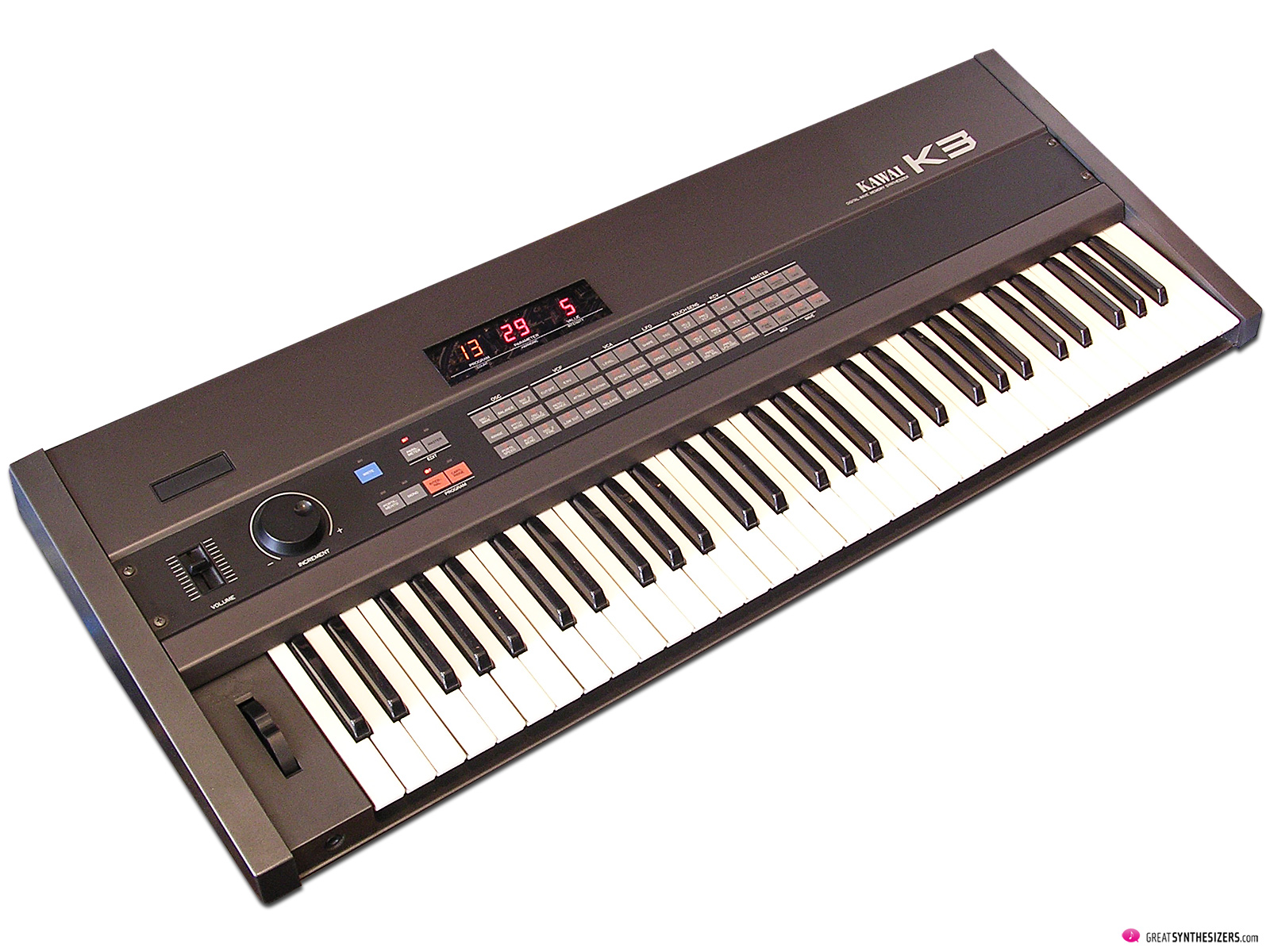
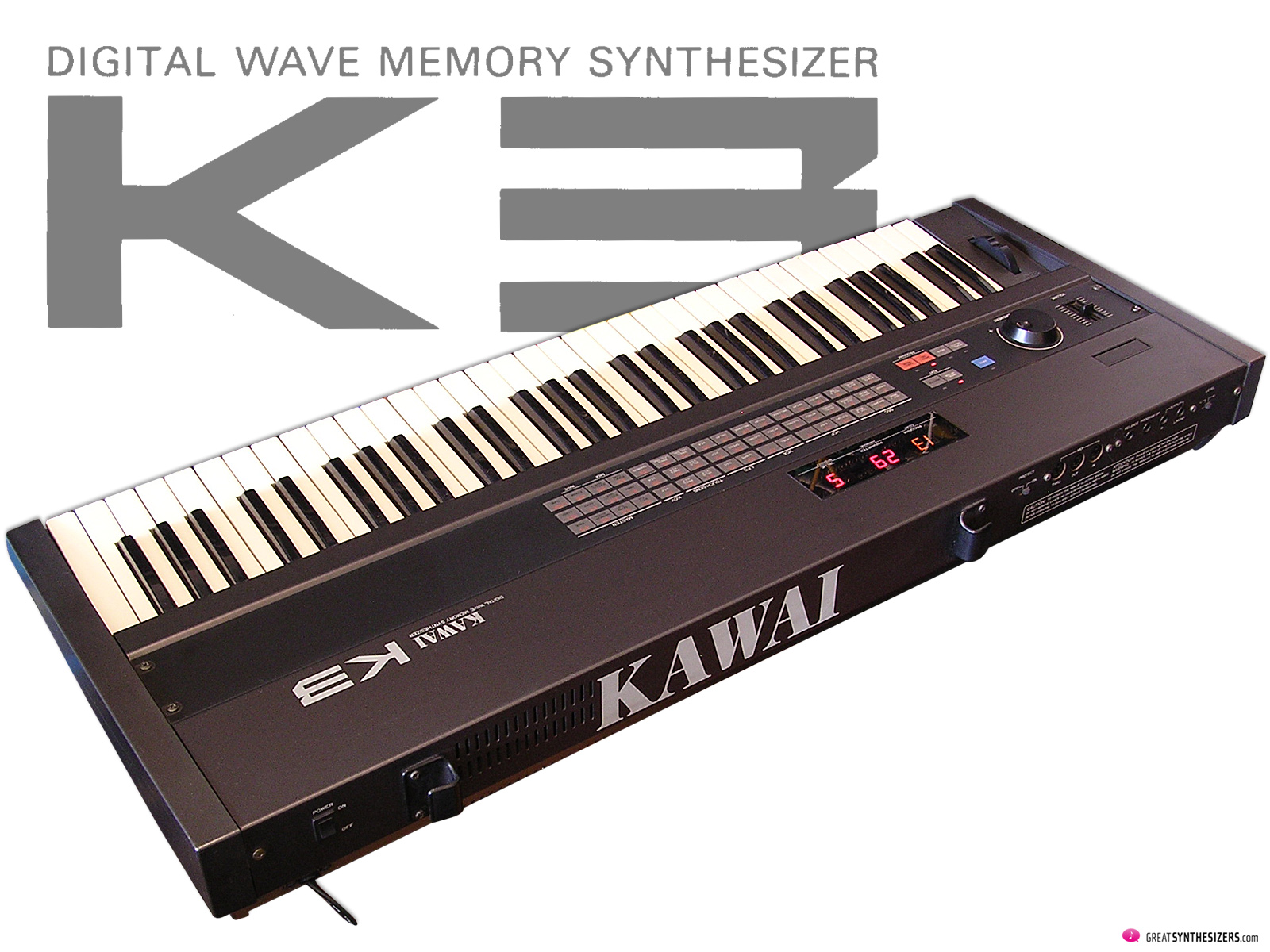
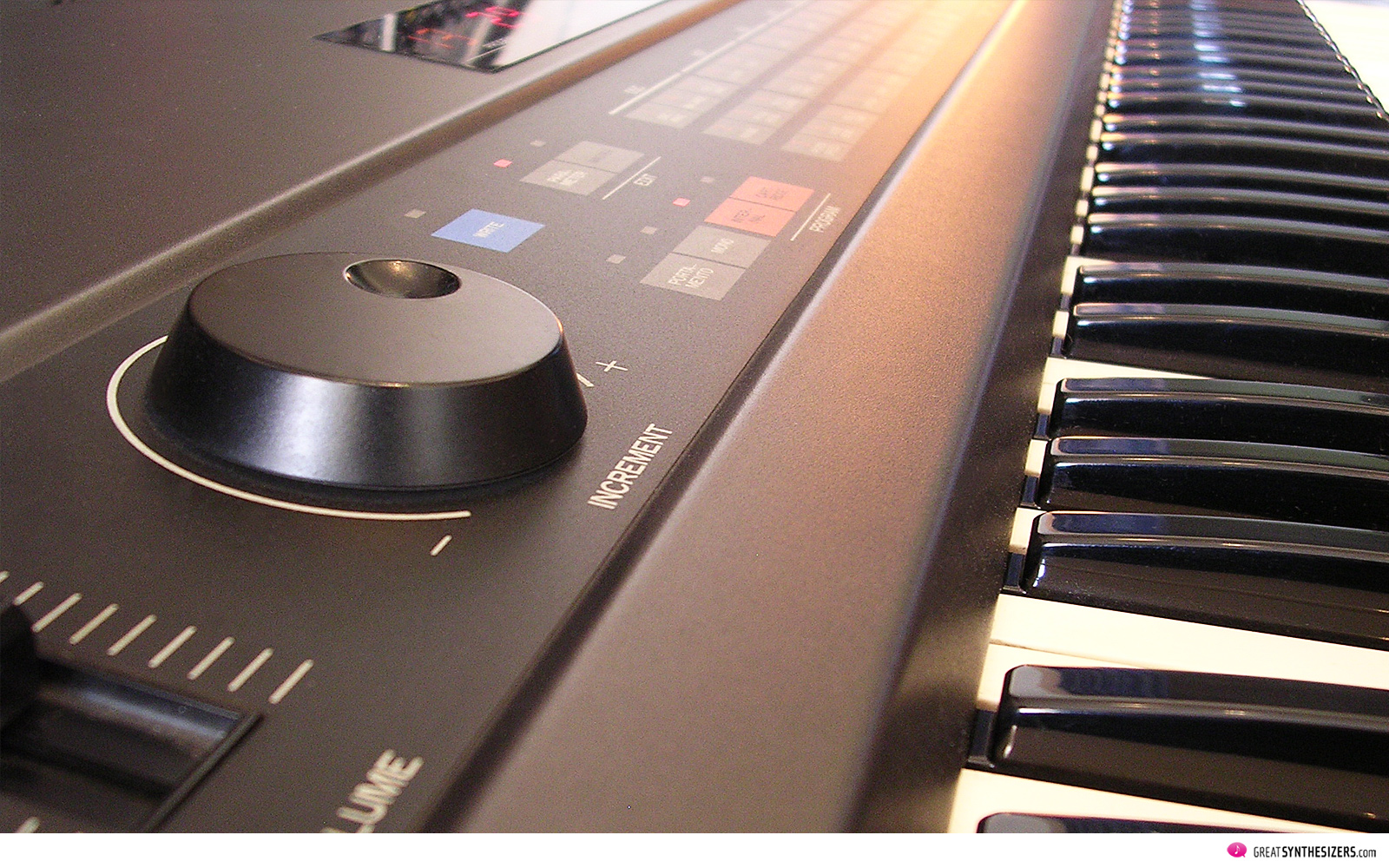
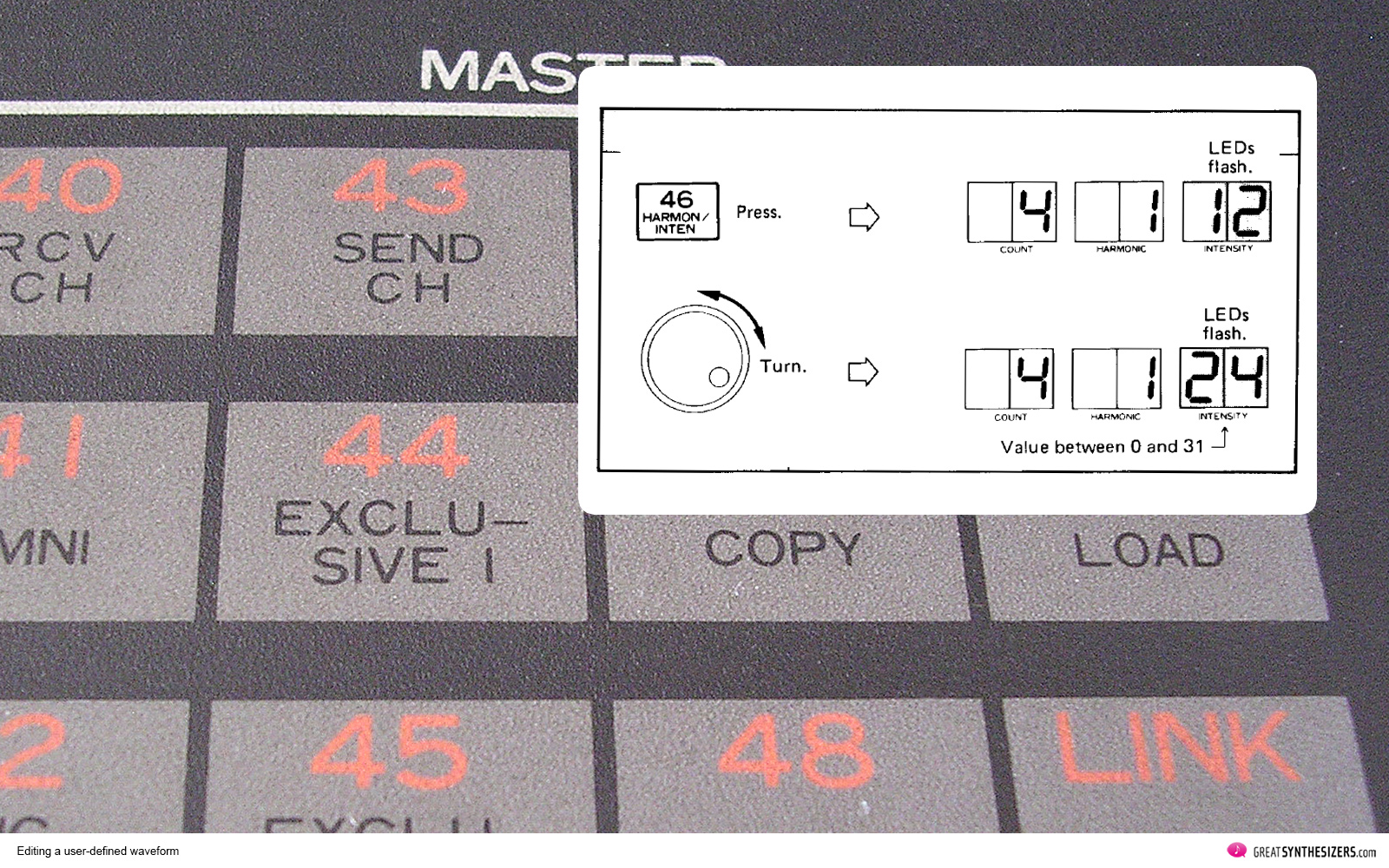

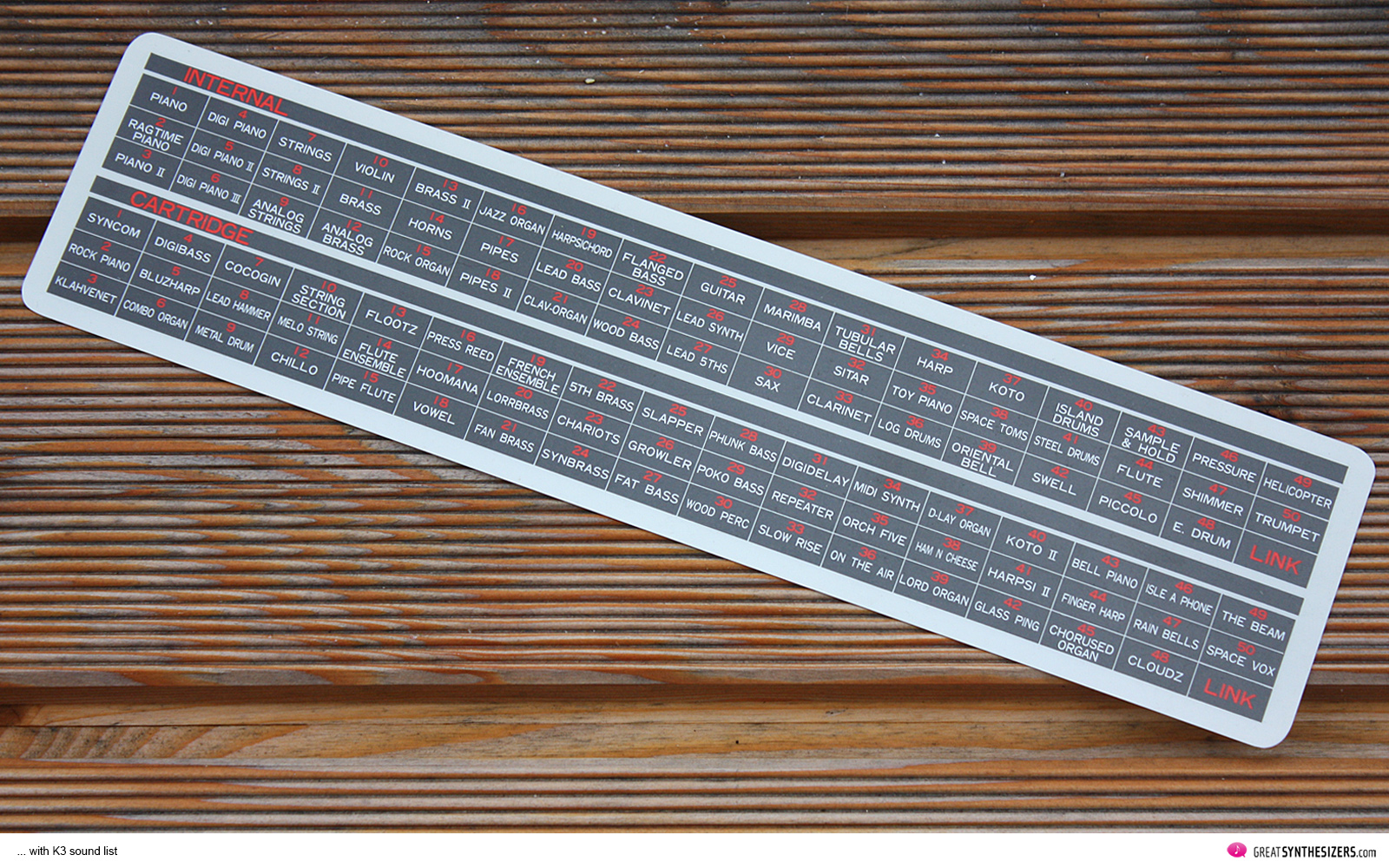
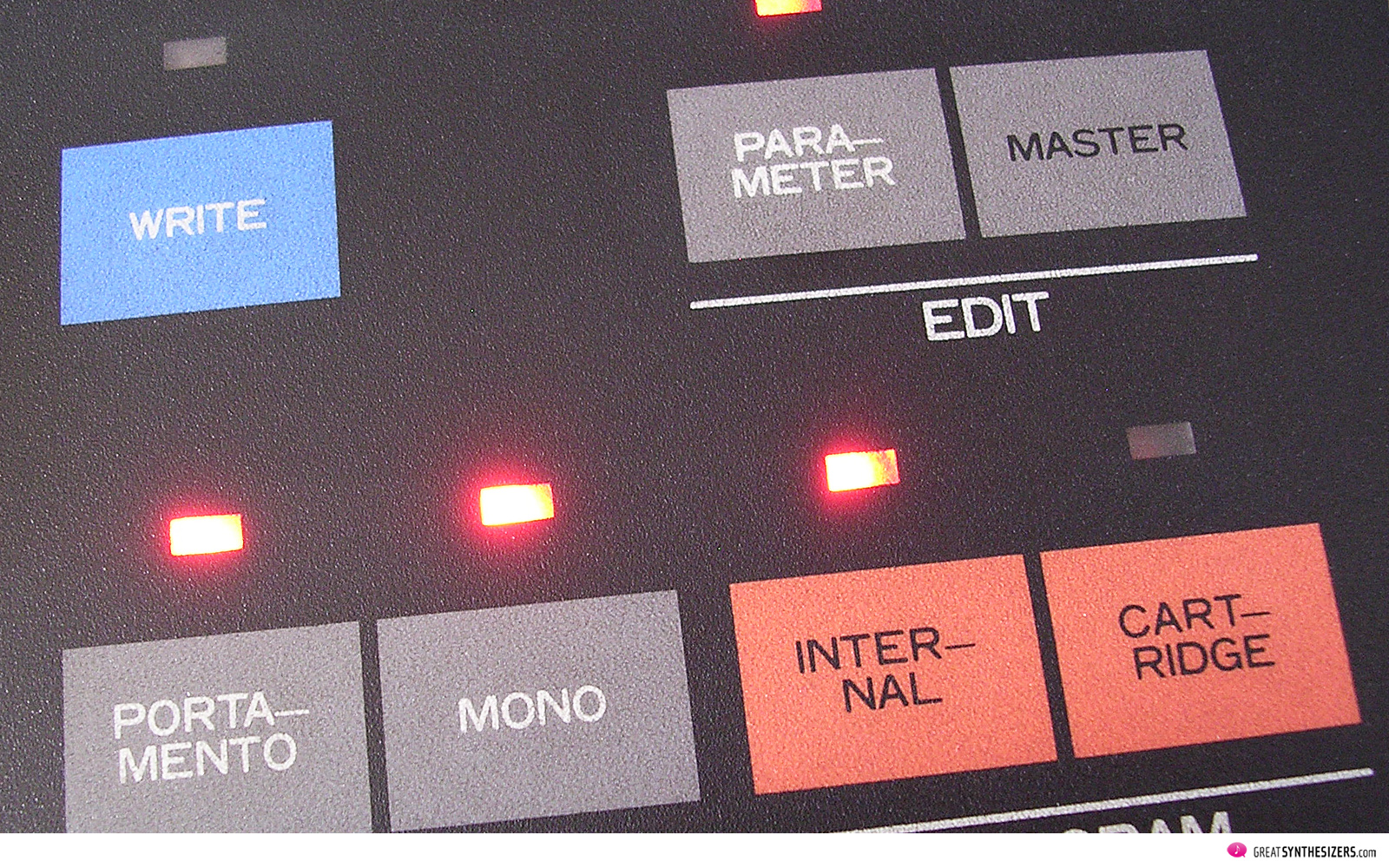


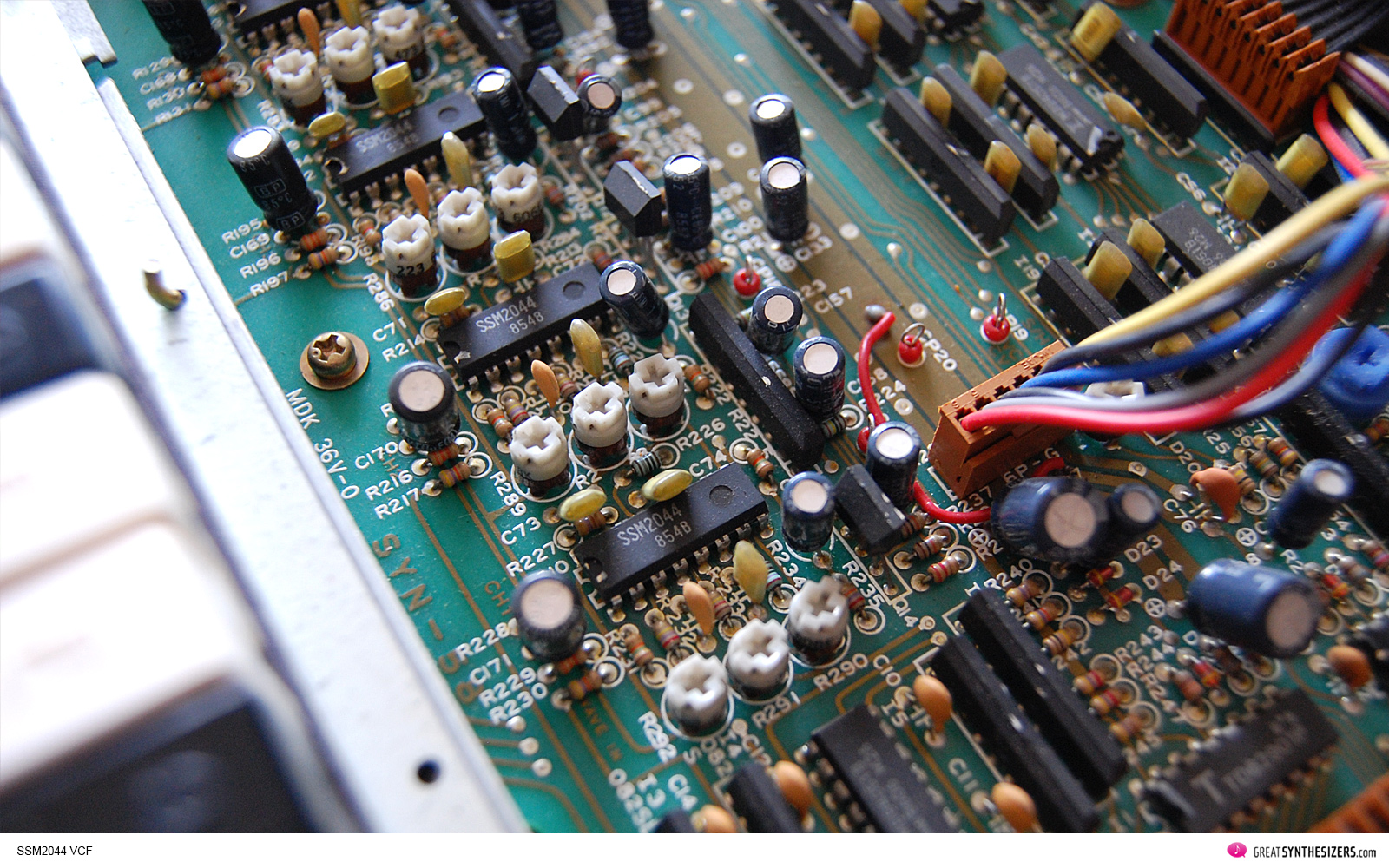
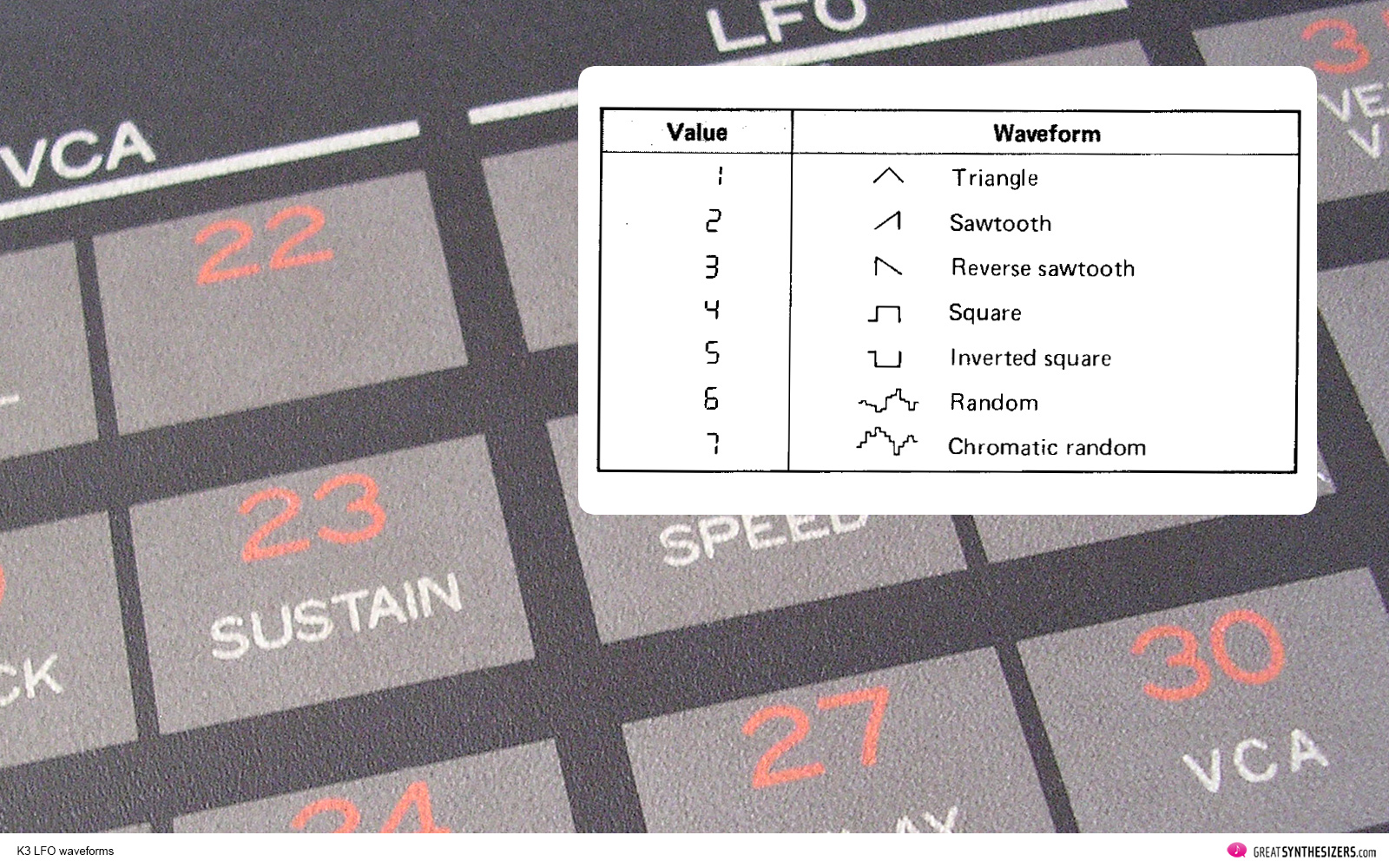
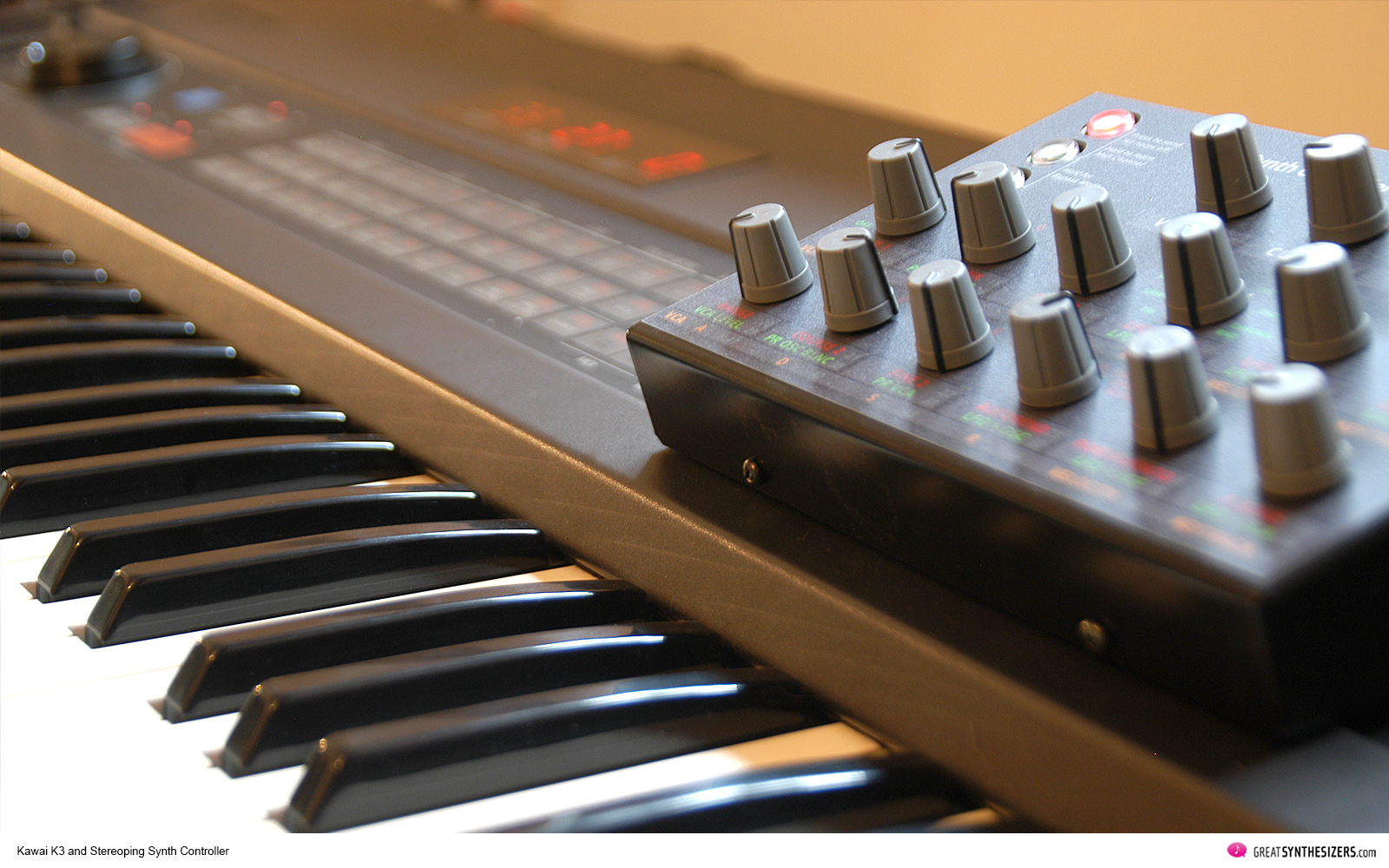
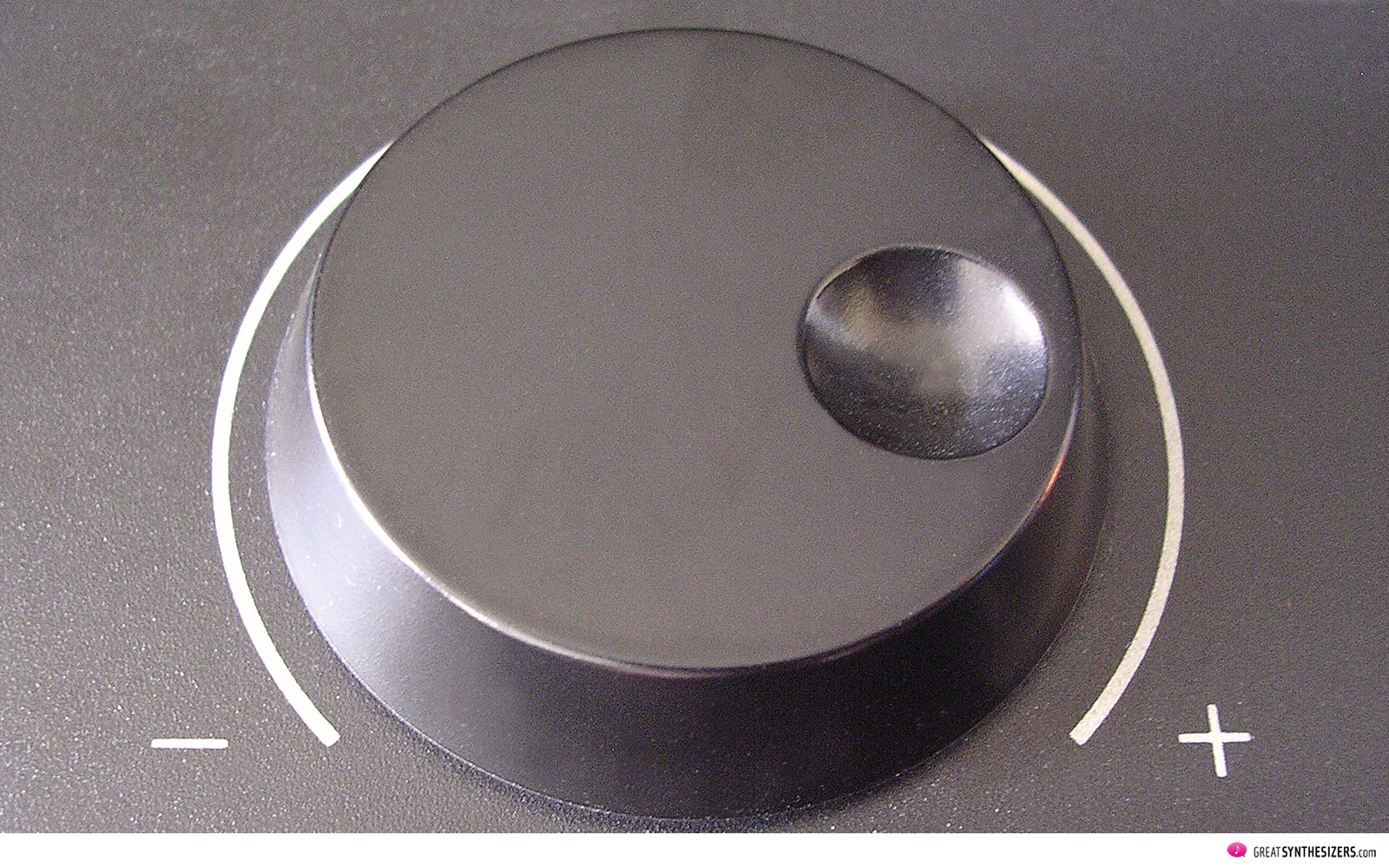
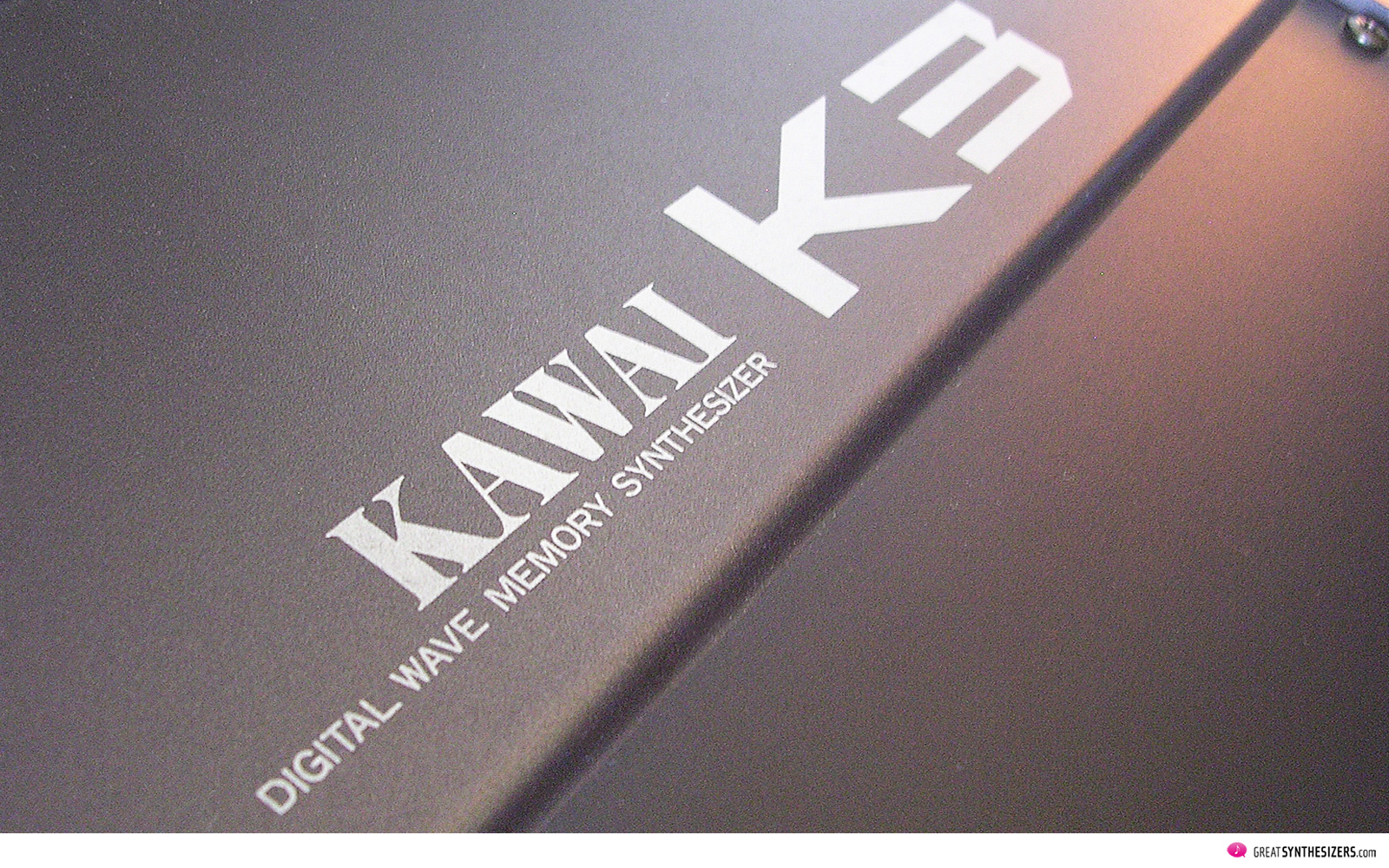
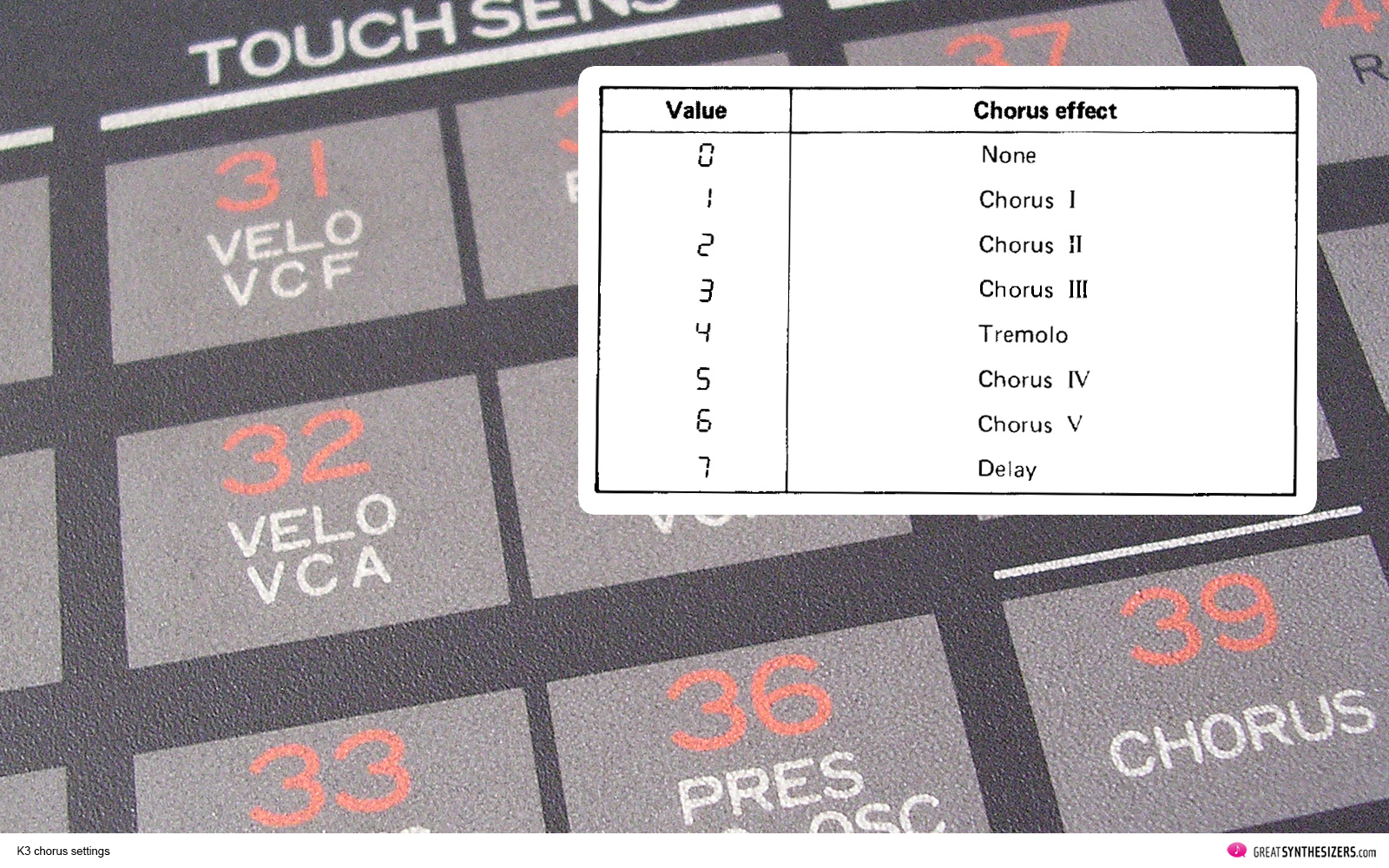
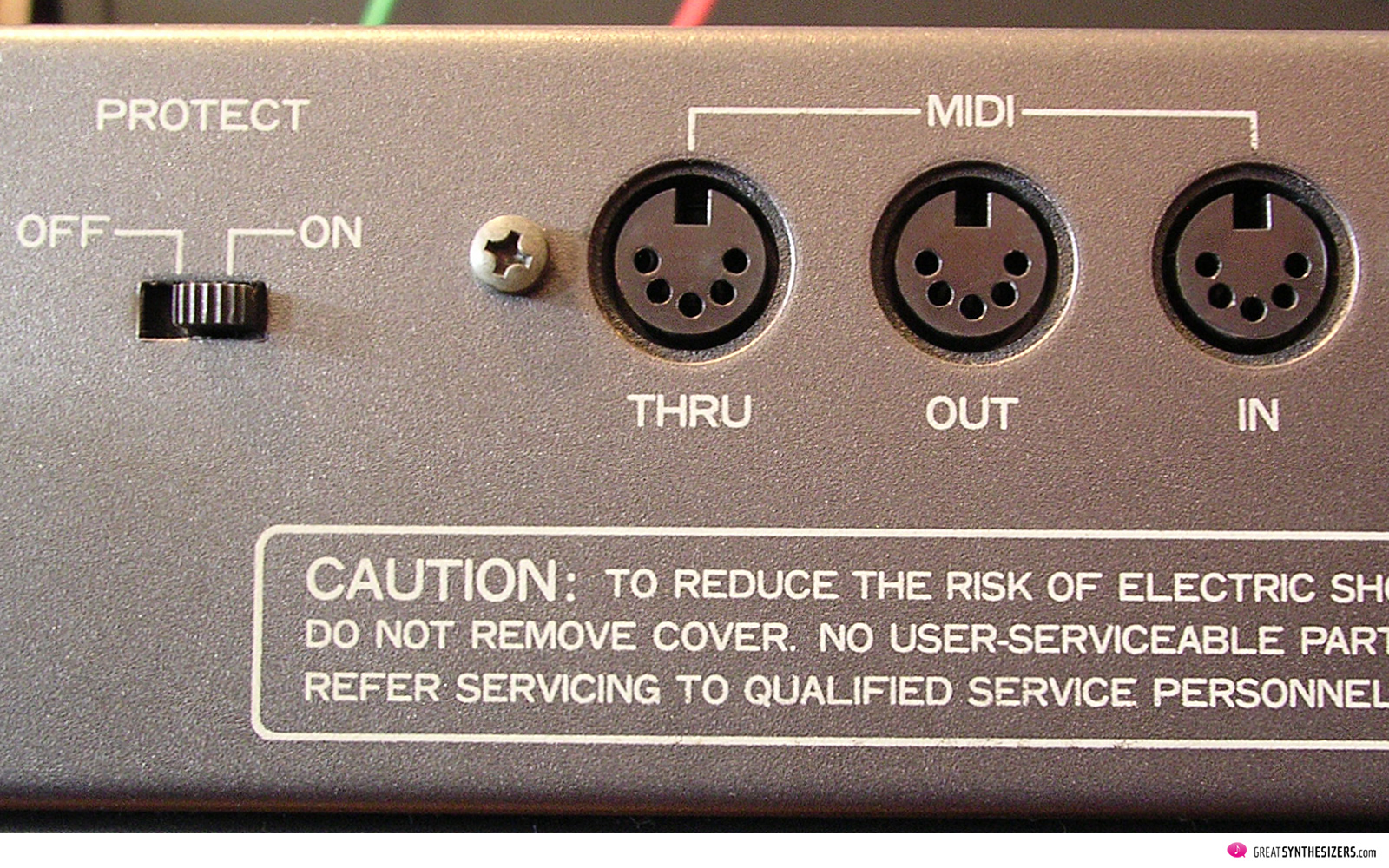
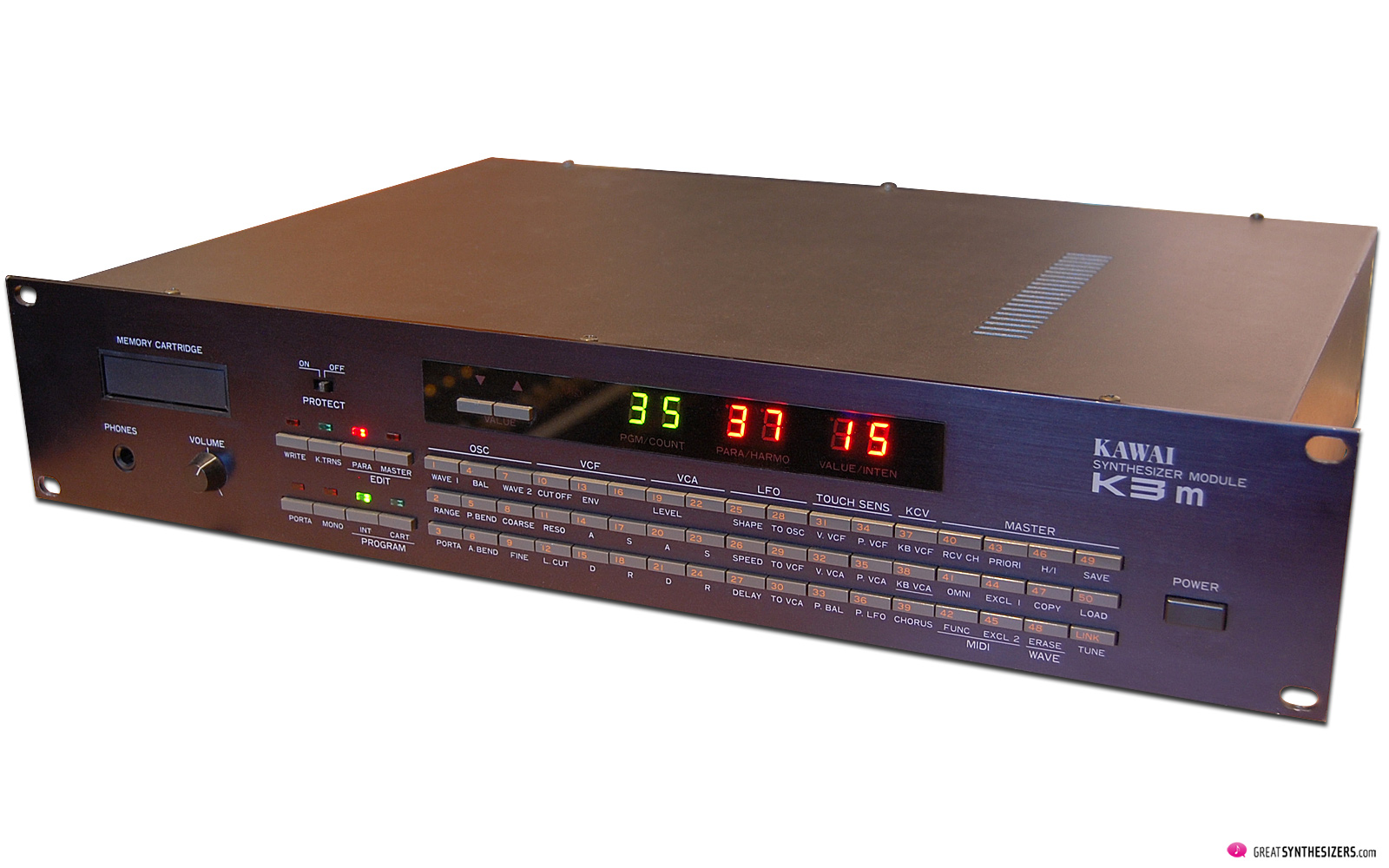
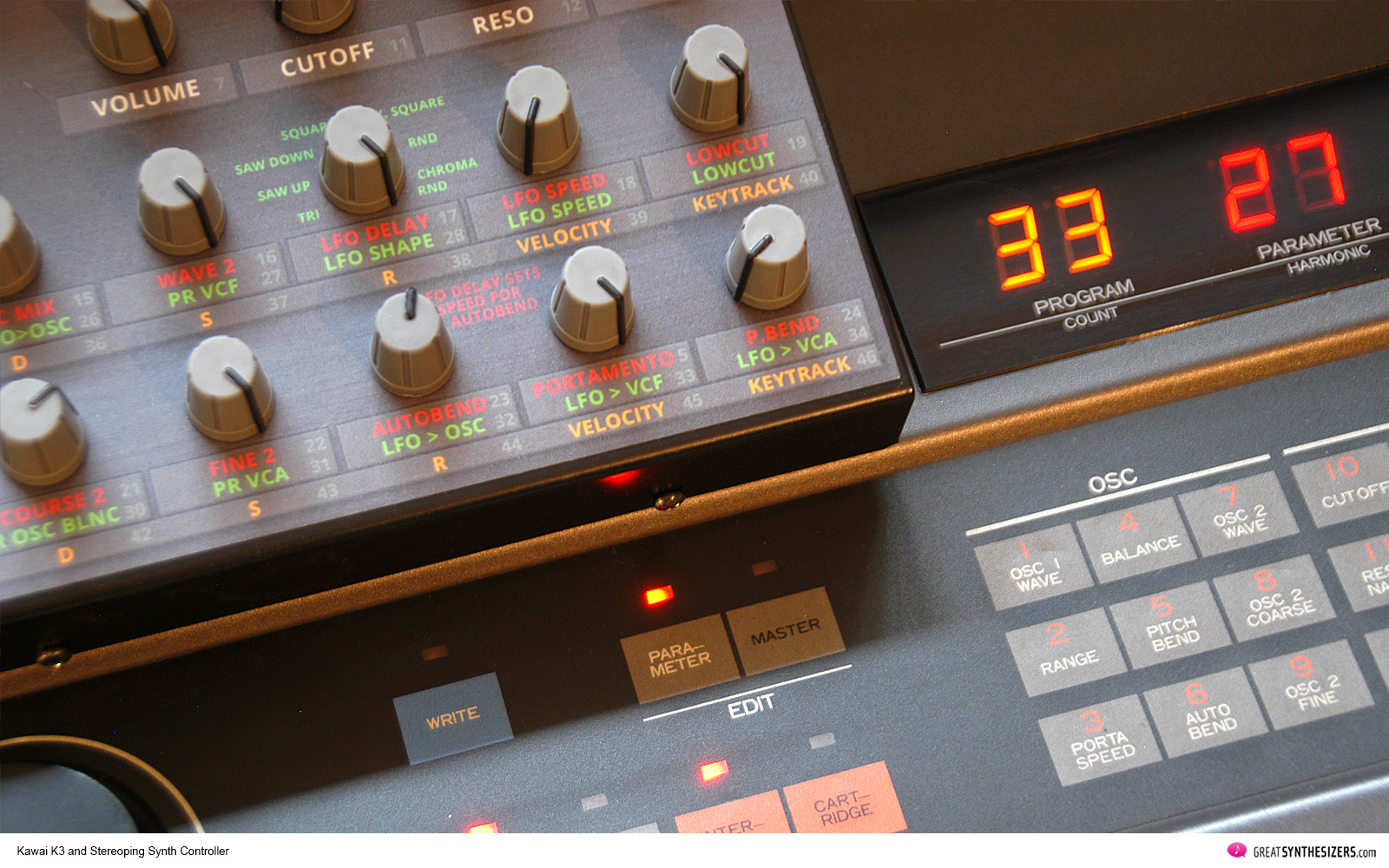


You’re absolutely correct about this being a special instrument. Of all the “hybrid” synths from the 80’s, (digital oscillators through analog VCF and VCA’s) this one definitely shines. The DW-8000 left me cold; the Ensoniq ESQ 1 is interesting but supposedly unreliable and nearly impossible to find replacement parts for and the PPG is far too expensive. Which only leaves the Waldorf Microwave 1 as any sort of competitor to the Kawai K3.
I have the K3m and it is a thing of beauty. It can sound like a PPG or an analogue poly, plus with some nice quirky features. The bass end can be trouser-shakingly boomy if you want, if not then the high cut filter comes to the rescue. Also bass sounds in Mono mode are enormous. I love the strange ethereal chord patches the machine produces, and the velocity controlled oscillator balance is a great feature, when playing “live” as expression or when using repetitive sequencer lines with random velocity parameters. I wouldn’t be without mine. (PS You’re right. It is quite rare. Rose Morris, the Kawai importers here told me there was no such thing as a K3 ever made!)
The internal chorus isn’t bad at all! Sure it has a bit of grit, but that can be quite interesting depending on the genre, it almost gives it that 90s hip hop sampled from vinyl sound so sought after these days.
I love this baby and I bought it yesterday for 180 bucks. I’ve already written 2 songs on it and I’m just incredible happy to add it to my arsenal. Digital/Analog hybrids for life!
… that’s great to hear. 180 bucks? You’re lucky …!
I am interested on buying one of them and it is likely I will grab one from eBay soon. I will let you know my opinion next week.
Thanks for your well documented expose. I actually like the chorus on the K3 a lot (I have a K3m btw): it might be noisy, but not so much more as most polysynths of that time – much better then the Korg DW series chorus FI -, and it really adds to the flavour of this machine. K3’s or K3m’s still pop up at eBay from time to time, usually at reasonable prices. Some owners complain about the flimsy membrane buttons of the K3 keyboard version, but the K3m has much more reliable pushbuttons.
I totally agree – thanks for this very well review.
The K3 was my first choice after a long time selling all my “old” gear believing that the software age will satisfy my needs to produce music for myself on my work travels around the world.
But i realized hardly that this took some soul out of my life.
So decided to spent some money on something what is in between digital and analog. I was quite familiar with Kawai and thought that even the digital products from the 90ies would benefit from some analog filters behind the digital sound engine. (like waldorf Mw1 or Korg DSS1)
I was surprised that there was exactly such an instrument made by Kawai. And i have to say this is still my soulmade in the late office hours after work. It feels i a bit like stone on wood. The bit cold but organic digi80ies-waves get harmonic shaped by pure analog filters.
It makes it to unique instrument – simple solid organic.
I own both – K3 and at home K3m.
They sound – totally different to me. I know this can’t be. But it´s true.
I exchange the patches with my cartridge from time to time.
The K3m sound much thinner and more glass to my me.
The K3 seems more darker and bass room.
Well i am happy to xchange patches,
Very beautiful Demo !
Really inspire ring , )
Toby
at
pfadfinderei.com
If you have a K3, it’s worth getting hold of a Behringer BCR2000. One of these will allow you to edit any of the synth’s parameters in real time. This makes it a far more intuitive synth to programme your own patches on from scratch, or simply tweak numerous parameters whilst playing.
Kawai-K3 is a monster hybrid Synthesizer. Everyone must have one to his studio. I have it for more than 15 years and still I am impressed. You can easily create a perfect sound in a few minutes. Ensoniq ESQ-1, is another monster.
Personally I don’t like PPG Wave and Microwave Synthesizers. I have sold them both. I never had the Korg DW-8000, but I have the Korg DSS-1 which is the greatest monster of all hybrids.
FYI, both the K3 and DW8000 don’t have LCD displays. They’re called LED. And as for the ones on the Korg being “prone to errors”, I still have mine since 1985, and never had any problems. I know a few friends who have theirs, and still no problems there either.
Hello Alain! Of course, you’re right – LEDs, no LCDs. Concerning the DW8000. I own both the keyboard and rack expander – both have problems with their LED. But yes, there are fine examples out there with no troubles. In general the DW6000 / DW8000 production line is “not” of highest hardware quality (in opposite to the Kawai K3). I guess this is what I wanted to say … Regards, Theo
Hello Theo ! Even the panel is more nicelly organized than Korg DW 8000, this machine looks more compact , but missing modulation wheel (which was stupid from Kawai), more limited real time controlers than DW, Kawai sounds less analog, organic to my ears! Regards from Dubrovnik, Croatia!
Hello Žarko! Yes, the K3 sounds more digital, in some ways. Reason might be its characteristic oscillator waveforms (samples). Anyway, it’s a fantastic music synthesizer. And the DW8000 – the player’s instrument – is a joy to perform (arpeggiator, joystick). Regards, Theo
Got mine at a yard sale for 20$…
Delightful article here. Proud owner of a secondhand Kawai K3. Going on 11 years now, it still finds its way into most of my productions and film score recordings. I’ve come across only one other peer using this rare synth. Without it, my sound just wouldn’t be.
Can anyone email me the quick guide for the K-3 sound and waves list? Send to: Tlcguitarist (at) me.com
Thank you
Recently bought one, but the beast is in quite bad shape.
I spent days giving it tlc, but the plastic membrane that lays over the switches needs to be replaced.
anybody knows where to find replacement?
Cheers to you all….
I have a Kawai K3 I bought new in 1986. I can’t get it to turn on. Are there internal fuses/batteries? If so, where can I find them or get it serviced? Thanks!
I must be the lucky one as my K3 chorus doesn’t make any extra noise at all. And I don’t get any bumblebees in my studio when it is turned on. People reviewing instruments for public review really ought to review only instruments that have been properly serviced and calibrated. Otherwise statements about noises and bumblebees become nagging blemishes on the reputation of an instrument when the problem is only with the reviewer’s model and that is irresponsible.
I do agree that the K3 finds a place in any mix and sounds quite organic. It can sound quite digital too with the filter opened up. It is a gorgeous instrument with alot of potential.
… you’re correct. Anyway, regarding the hum of the power supply it says: “… I don’t know if this is true of all K3 models, but …”.
However, I understand your argument and changed some explanations. A cautious use of descriptions should be the basis for any review.
Best regards …
I was able to order some replacement keys for my old K3 from Kawai a few years ago. Perhaps they’d have a replacement membrane sheet available. Ask for their technical service division.
http://www.kawaius.com
310-223-2722
I am proud to own a still working Kawai K3. I would love to get a K3m to go with it. Somewhere over time I have managed to lose the wave table card, and the flip side which shows the names of pre-programmed factory default instruments. If anyone has one they would like to send a good picture of, I’d appreciate it.
Andre Hut: I have the card, I can send photos of it. Are we allowed to put an email address here? I’m: danclegg at gmail dot com
I own a K3, a Korg DW-8000, an Ensoniq ESQ-1, and a Roland JX-8P — and about 30 other synths to be honest.
You ever see that Twilight Zone with the guy working in the wax museum? The wax museum has to close down and he takes it upon himself to store those wax figures in his basement, taking great care to keep the A/C running 24/7 so they’re in good shape. Eventually his wife leaves him. There’s more to the story of course, but that’s besides the point.
Sound-wise the K3 seems more like Roland’s JX-8P to me than the DW-8000. Not only are our opinions in some respect subjective, but with either synth i didn’t go all that far beyond the presets. It also seems very similar to my Ensoniq ESQ-1 though of course the ESQ has Curtis filter chips instead.
The K3 makes great furniture. Not only is it the most solidly built of the 4 but you can set a stack of sheet music and make corrections to what you’re writing. It has the most “organ-like” keyboard of any of my instruments.
Oh, and the chorus on mine isn’t noisy at all.
… hi Brian. Thanks for the great comment and info. Right, the Ensoniq ESQ-1 (and SQ-80) needs to be mentioned here as well! Wonderful, interesting and very powerful sounds (and a clumsy keyboard :o). Serious instruments!
I recently got ahold of a K3m, but can’t for the life of me figure out how to perform a sysex patch dump/load. I have many synths and can get them all to dump/load using SysEx Librarian for Mac, but despite playing with all of the K3m MIDI settings I can think of, no dice. If anyone knows of a specific “trick” to get it to work please let me know.
W. James. I know all about the K3/K3m. I have a K3 and two K3m, and I’ve done extensive MIDI programming with these synthesizers.
I own both the K3 and DW-8000; both are great/fun. I disagree with the build quality comparison, the K3 *feels* more solid but K3’s often have broken D, G, and A keys (not so with the DW) and my heavily used 30+ year old DW joystick is just fine. The DW has a DDL rather than chorus – able to do everything the K3 chorus does an more and I have never been concerned with DW DDL noise. The more complex DW envelopes allow for better percussive strikes to sounds. Again, I like them both but would not claim the K3 is better.
It’s too easy and that confused me also. The Exclusive I, button 44 has to be “On” (1) .
The SYSEX software has to be “Waiting to Receive Sys Ex Messages”
Then you simply press the patch and its immediately sends the SysEx for that patch.
If you go and press from patch 1 to 50 waiting one second in between or less you can have the whole Internal bank as one Sys Ex instead of 50 individual patches.
Same works for sending the Cartridge patches. However when sending this to the K3 they will also go into the cartridge not the internal memory.
This is years later and it may not matter, but there is a guy in England now making replacement membrane panels for the K3, as well as the JX-8P, DX7, and others. https://www.sweetdiscrete.co.uk/
There’s nothing like “membrane buttons” here – under membrane foil there are microswitches, that means real switches.
… thanks for the note. I’ll fix that in the test report. Kind regards – Theo